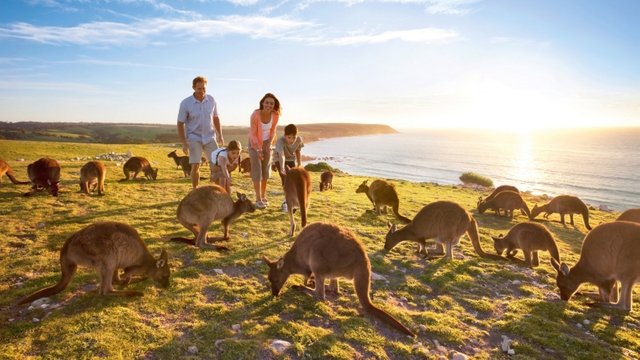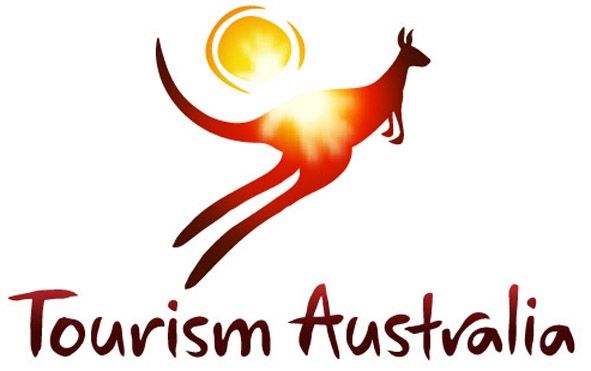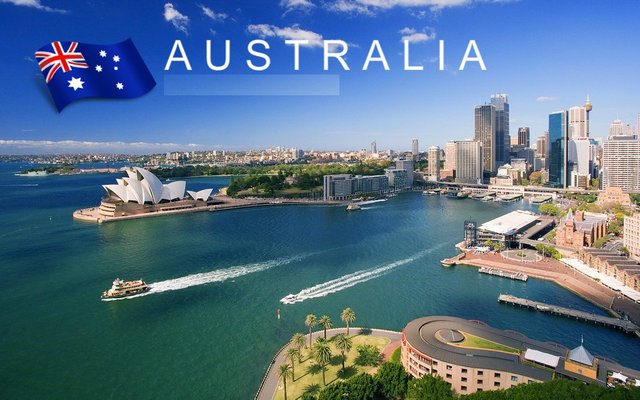Tourism in Australia

Tourism in Australia is an important component of the Australian economy. In the financial year 2014/15, tourism represented 3.0% of Australia's GDP contributing A$47.5 billion to the national economy.Domestic tourism is a significant part of the tourism industry, representing 73% of the total direct tourism GDP.
In calendar year 2015, there were 7.4 million visitor arrivals.Tourism employed 580,800 people in Australia in 2014-15, 5% of the workforce.About 43.7% of persons employed in tourism were part-time. Tourism also contributed 8.0% of Australia's total export earnings in 2010-11.
Popular Australian destinations include the coastal cities of Sydney, Brisbane and Melbourne, as well as other high-profile destinations including regional Queensland, the Gold Coast and the Great Barrier Reef, the world's largest reef. Uluru and the Australian outback are other popular locations, as is the Tasmanian wilderness. The unique Australian wildlife is also another significant point of interest in the country's tourism.
Trends

Despite the global economic challenges and natural disasters in 2010-2011, Australia's tourism growth was supported by increased consumption (up 4.4% over the previous year, largely due to an increase in the number of visitors from overseas). On the back of a strong Australian dollar, 2010-11 also saw a record 7.4 million short-term resident departures from Australia, an increase of 9.9% from 2009-10. Domestic tourism consumption grew at less than half the pace of international consumption in 2010-11 (up 2.1% compared to 4.4%).
The Australian Government released the 2020 Tourism Industry Potential on 15 November 2010, and estimates the Australian tourism industry to be worth up to $140 billion in overnight expenditure. This growth will largely be due to key emerging markets, including the China market, which is estimated to be the largest economic contributor to the Australian tourism industry by 2020.The number of Chinese visitors has more than doubled from 2006 to 2012 reaching a peak of 626,400 in 2012 and surpassing for the first time the number of arrivals from the United Kingdom.In 2013, China was Australia's fastest growing tourist market.According to Tourism Australia Managing Director Andrew McEvoy, the Chinese are the highest spending visitors to the country.
Visas
Main article: Visa policy of Australia
All visitors to Australia, apart from New Zealanders, require advance permission to enter the country. For most countries, a full visa is required. Holders of passports of all European Union countries as well as all Schengen Area countries and European microstates only need to apply online for an eVisitor authorisation. Citizens of some OECD and some East Asian countries are able to apply for the similar Electronic Travel Authority authorisation.
History

From colonial days the idea of travel has been more natural to Australians than to people long established at one from their homes, were prone to continue their search for wealth or security for a while, or, having settled down, to return to the old countries to visit their kin and refresh old memories. The opening of new lands, the establishment of industries and towns and the consequent dispersal of people over Australia created a habit of mobility and enterprise which encouraged Australians to face the hardships of early travel by coach, on horseback or by ship. Even so, the slow and uncomfortable modes of travel and the vast distances separating Australian towns tended to restrict travel to essential journeys for purposes of trade, to pursue an occupation or to settle. This changed somewhat with the advent of rail travel.
The initial emphasis in tourism for purposes of pleasure was strongest on travel to resorts near the main population centres. These included the Blue Mountains in New South Wales and the hill and coast resorts close to Melbourne and other major Victorian cities. The existing railway services radiating from those cities, together with the 'feeder' horse-drawn, and later motor, coach transport connecting with the railways, rendered the State Government railway tourist bureaux the main means for selling intrastate, and even some interstate, travel.
After the 1914-18 War in the 1920s, and again after the easing of the effects of the Great Depression of the 1930s, travel for all purposes increased steadily. This period saw the establishment of the Australian National Travel Association with bureaux in the UK and USA.The organisation received government funding on top of industry contributions and promoted the country 'vigorously' via a poster campaign and from 1934 via Walkabout magazine.
Traffic in tourism continued to be mainly by rail, but also by sea, although the family motor era began in the 1930s to participate in the shorterintrastate traffic. A considerable fleet of passenger ships provided frequent and popular services linking most ports between Fremantle and Cairns. Other services linked Sydney and Melbourne with Tasmanian ports. The winter cruise of those days to Queensland ports could be regarded as the equivalent of today's drive or flight north for a winter holiday at the Gold Coast or a Barrier Reef Island, or today's shorter South Pacific cruises. The first cruises from Australia to New Zealand were organised in the summer of 1934-35, and Australians were travelling to Britain for as low as $78 in tourist class in the years immediately preceding the 1939-45 War.
In the period following the 1939-45 War the advent of new and improved methods of transportation, combined with rising standards of living and the energetic publicising of foreign destinations, developed international travel into a mass-movement. New ocean liners shortened travelling time considerably, and travel by car and bus increased in many countries. Most of all, air travel became widely available, faster, safer, and cheaper. The beginning of the jet age in 1960, with larger aeroplanes carrying more than 100 passengers at speeds approximating 600 miles per hour, diminished the world by half in terms of time. Rising standards of living in the post-war period led to greater expenditure on tourism, thus making it more important to the national economy.
Australia has shared in this worldwide expansion of travel, particularly in respect of its domestic tourism. Because of the marked increase in incomes and private car ownership among large sections of the population, greater leisure time, three weeks paid annual holidays (introduced first in New South Wales in 1958) and the introduction of long-service leave, thousands of Australians now travel by road into almost every part of the Commonwealth. This has led to investment in the development of new and improved facilities, especially accommodation, of new resorts at dispersed points around Australia, and to modifications in organisation and methods of tourist administration, development and promotion. These activities in turn have had an important influence on matters such as the improvement of highways and the opening up of national parks and foreshores. A recent consequence is the first detailed study and survey of the entire Australian tourist industry, its development and its future potential.
Marketing
Australia's international tourism campaigns have focused on Australia's laid back style, such as an 1980s advertising campaign featuring actor Paul Hogan telling American tourists "I'll slip an extra shrimp on the barbie for you", or its cheeky side, as in its controversial 2006 campaign in the United Kingdom using the Australian colloquialism slogan "So where the bloody hell are you?".
Tourism Australia's "No Leave No Life" campaign was launched in March 2009 by the Federal Minister for Tourism, the Hon. Martin Ferguson AM MP. This campaign was designed to remind employees of the personal and professional benefits of taking annual leave, and of taking that leave in Australia. At 30 June 2009 there were 126 million days of stockpiled annual leave in the Australian economy.At the end of the June 2010 quarter, this number had decreased to 117 million days, following falls in the preceding three quarters.
Tourism Australia's latest consumer campaign "There's Nothing Like Australia" invites Australians to share their favourite Australian place or experience with the world.
The campaign is based on research conducted by Tourism Australia that showed Australians were eager to get involved in promoting their country. It was developed to involve Australians because they are the experts on what makes Australia unlike anywhere else. The core message, that "There's Nothing Like Australia" was designed for longevity through different mediums, audiences and activities.
wow Australia is really best for tour
A very much informative article. The Australian economy is going to reap off lots of earnings from growing trourism trend!
thnx alot